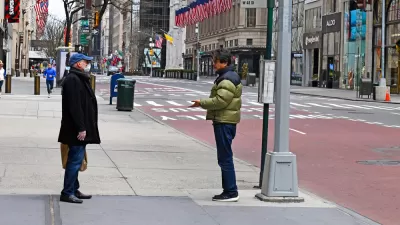The former locations of nuclear missile sites are more mundane than you probably realize. Geoff Manaugh explores satellite images of Los Angeles, and other cities, for examples.
Geoff Manaugh writes:
During the Cold War, many missile defense sites—precisely because their purpose was to guard infrastructure of vital national interest—were housed in urban or suburban locations. Los Angeles in particular, thanks to its aerospace facilities, military bases, and booming postwar population, became one of the most fortified regions in the United States.
A surprisingly long list, and corresponding collection of satellite images, follows that statement, showing locations around the city that are familiar to even short-term residents of Los Angeles. Manaugh also notes another variety of former nuclear facility found in the region:
In other cases, L.A.'s former missile sites have blended back into the natural landscape with an ease that is both ecologically inspiring and somewhat disconcerting, with nature's apparent triumph serving as an acknowledgement of the narrowly averted horrors of nuclear war. The launch site known as LA-43L is now a public park and "nature education center" near the coast west of Long Beach. Aside from an aging concrete pad beneath which missiles were once kept, the most distinctive feature of the landscape today is a Native Plant Demonstration Garden.
The article includes lots of links to previous coverage of the facilities, as well as the kicker: these facilities, found in cities all over the country, "remain an otherworldly reminder of how close our nation came to doomsday."
FULL STORY: Where Los Angeles and Other American Cities Used to Store Their Nuclear Missiles

Planetizen Federal Action Tracker
A weekly monitor of how Trump’s orders and actions are impacting planners and planning in America.

San Francisco's School District Spent $105M To Build Affordable Housing for Teachers — And That's Just the Beginning
SFUSD joins a growing list of school districts using their land holdings to address housing affordability challenges faced by their own employees.

The Tiny, Adorable $7,000 Car Turning Japan Onto EVs
The single seat Mibot charges from a regular plug as quickly as an iPad, and is about half the price of an average EV.

Vehicle-related Deaths Drop 29% in Richmond, VA
The seventh year of the city's Vision Zero strategy also cut the number of people killed in alcohol-related crashes by half.

Seattle's Plan for Adopting Driverless Cars
Equity, safety, accessibility and affordability are front of mind as the city prepares for robotaxis and other autonomous vehicles.

As Trump Phases Out FEMA, Is It Time to Flee the Floodplains?
With less federal funding available for disaster relief efforts, the need to relocate at-risk communities is more urgent than ever.
Urban Design for Planners 1: Software Tools
This six-course series explores essential urban design concepts using open source software and equips planners with the tools they need to participate fully in the urban design process.
Planning for Universal Design
Learn the tools for implementing Universal Design in planning regulations.
Smith Gee Studio
City of Charlotte
City of Camden Redevelopment Agency
City of Astoria
Transportation Research & Education Center (TREC) at Portland State University
US High Speed Rail Association
City of Camden Redevelopment Agency
Municipality of Princeton (NJ)





























